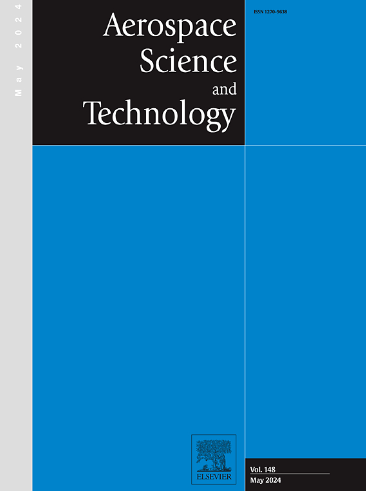Study on the interaction mechanism between incident oblique shock wave and transpiration cooling and optimization of porosity
IF 5
1区 工程技术
Q1 ENGINEERING, AEROSPACE
引用次数: 0
Abstract
Transpiration cooling, due to its high cooling efficiency, is used for thermal protection in hypersonic aircraft. However, oblique shock waves incident on a structural surface can reduce cooling effectiveness, risking thermal protection failure. Additionally, the cooling film changes the wave structure in the main flow, reducing the aerodynamic performance. This study employs numerical methods to analyze the effects of oblique shock waves on transpiration cooling at various shock incidence angles and coolant blowing ratios, as well as the influence of transpiration cooling on the main flow field. The cooling efficiency curve is segmented into four intervals based on the flow mechanisms, with the corresponding optimization objectives proposed. A segmented porosity design method driven by pressure difference is adopted, improving the surface temperature uniformity at the hot end of the transpiration zone by 82.7%.
斜入射激波与蒸腾冷却的相互作用机理及孔隙度优化研究
蒸腾冷却由于其高冷却效率,被用于高超声速飞机的热防护。然而,斜激波入射到结构表面会降低冷却效果,有热保护失效的风险。此外,冷却膜改变了主流中的波浪结构,降低了气动性能。本研究采用数值方法分析了不同激波入射角和冷却剂吹气比下斜激波对蒸腾冷却的影响,以及蒸腾冷却对主流场的影响。根据流动机理将冷却效率曲线划分为4个区间,并提出相应的优化目标。采用压差驱动的分段孔隙度设计方法,使蒸腾区热端表面温度均匀性提高82.7%。
本文章由计算机程序翻译,如有差异,请以英文原文为准。
求助全文
约1分钟内获得全文
求助全文
来源期刊

Aerospace Science and Technology
工程技术-工程:宇航
CiteScore
10.30
自引率
28.60%
发文量
654
审稿时长
54 days
期刊介绍:
Aerospace Science and Technology publishes articles of outstanding scientific quality. Each article is reviewed by two referees. The journal welcomes papers from a wide range of countries. This journal publishes original papers, review articles and short communications related to all fields of aerospace research, fundamental and applied, potential applications of which are clearly related to:
• The design and the manufacture of aircraft, helicopters, missiles, launchers and satellites
• The control of their environment
• The study of various systems they are involved in, as supports or as targets.
Authors are invited to submit papers on new advances in the following topics to aerospace applications:
• Fluid dynamics
• Energetics and propulsion
• Materials and structures
• Flight mechanics
• Navigation, guidance and control
• Acoustics
• Optics
• Electromagnetism and radar
• Signal and image processing
• Information processing
• Data fusion
• Decision aid
• Human behaviour
• Robotics and intelligent systems
• Complex system engineering.
Etc.
 求助内容:
求助内容: 应助结果提醒方式:
应助结果提醒方式:


